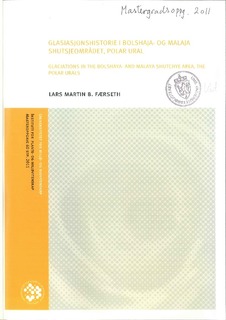| dc.contributor.author | Færseth, Lars Martin Berge | |
| dc.date.accessioned | 2011-11-18T12:57:14Z | |
| dc.date.available | 2011-11-18T12:57:14Z | |
| dc.date.issued | 2011-11-18 | |
| dc.identifier.uri | http://hdl.handle.net/11250/189360 | |
| dc.description.abstract | Geomorfologi og sedimentfordeling i området rundt innsjøene Bolshaja- og Malaja Shutsje i Polar Ural i Nord-Russland har blitt studert i felt og på flyfoto. Målsetningen med arbeidet har vært å kartlegge spor etter påvirkning fra det tidligere Barents-Karaisdekket, samt spor etter fremstøt fra breer med akkumulasjonsområde i fjellkjeden.
Sub- og proglasiale landformer og avsetninger kartlagt i dette studiet støtter antagelser fra tidligere studier om at Barents-Karaisdekket lå over fjellkjeden i midt pleistocene, og at utløpere fra Barents-Karaisdekket som omga fjellkjeden i tidlig weichsel presset seg inn i lavereliggende områder i dalene nær fjellfoten. Observasjoner, og dateringer av flyttblokker med kosmogene isotoper (10Be) som er utført i forbindelse med dette studiet og i forbindelse med ICEHUS-prosjektet (feltsesongene 2007 og 2009) støtter også antagelsen om at det kan ha blitt dannet større breer med sentrum i fjellkjeden i tidlig-/midt weichsel.
Datering av blokker fra sandurer og morenerygger med kosmogene isotoper (10Be) gjort i forbindelse med dette studiet, og i forbindelse med ICEHUS- prosjektet (2007 og 2009) tyder på at det også var et større brefremstøt fra breer med sentrum i fjellkjeden i sen weichsel og et senere, mindre fremstøt antagelig i holocene. Dette til forskjell fra tidligere undersøkelser som har konkludert med at det bare var et mindre brefremstøt i sen weichsel, og at breene i området har vært nærmest lik dagens breer i løpet av holocene.
Abstract
Geomorphology and sediment distribution in areas surrounding the lakes Bolshaya- and Malaya Shutchie in the Polar Urals, Northern Russia, have been studied in the field and using aerial photos. The objectives of the study have been to map features related to the impact of glacier advances from the previous Barents-Kara Ice Shield, as well as advances from glaciers that accumulated within this part of the mountain range.
Sub- and proglasial features mapped as part of this study support earlier studies suggesting that the Barents-Kara Ice Shield covered the mountain range during the Middle Pleistocene period, and that outlet glacier from the Barents-Kara Ice Shield surrounding the mountains during the Early Weichselian inundated the lower parts of the mountain valleys at the piedmont. Observations and cosmogenic isotope (10Be) dating of erratics made in this study and in connection with the ICEHUS-project (field seasons 2007 and 2009) also support the assumption that extensive glacier formed in the mountain range during the Early-/ Middle Weichselian.
Cosmogenic isotope (10Be) dating of boulders resting on morainic ridges and sandur deposits collected as part of this study and also in the ICEHUS-project (2007 and 2009) imply that there was a significant glacier advance from glaciers that originated in the mountain chain during the Late Weichselian, and a later, but smaller advance probably during the Holocene. This contradicts earlier studies that have concluded that glaciers were probably not much larger during the Late Weichselian than today, and that they maintained about the same size as at present throughout the Holocene.
| no_NO |
| dc.language.iso | nob | no_NO |
| dc.subject | kvartærgeologi | no_NO |
| dc.subject | glasiasjonshistorie | no_NO |
| dc.subject | Polar Ural | no_NO |
| dc.subject | Russland | no_NO |
| dc.subject | Polar regions | no_NO |
| dc.subject | Russian federation | no_NO |
| dc.title | Glasiasjonshistorie i Bolshaja- og Malaja Shutsjeområdet, Polar Ural | no_NO |
| dc.title.alternative | Glaciations in the Bolshaya- and Malaya Shutchye area, The Polar Urals | no_NO |
| dc.type | Master thesis | no_NO |
| dc.subject.nsi | VDP::Mathematics and natural science: 400::Geosciences: 450 | no_NO |
| dc.subject.nsi | VDP::Mathematics and natural science: 400::Geosciences: 450 | no_NO |
| dc.source.pagenumber | 72 | no_NO |
